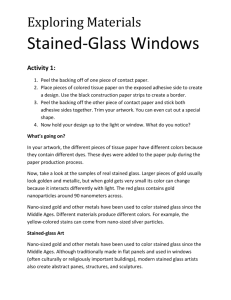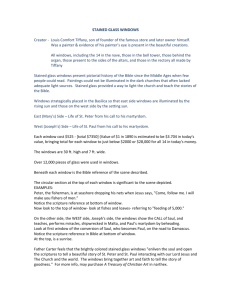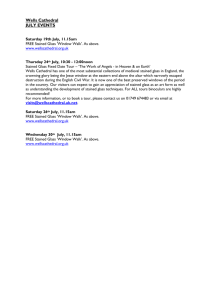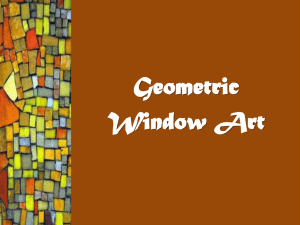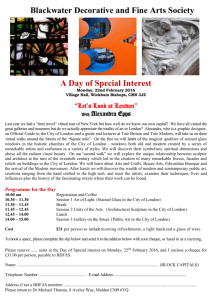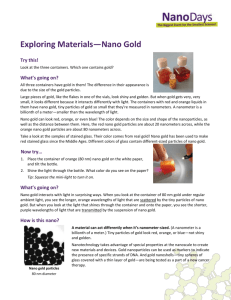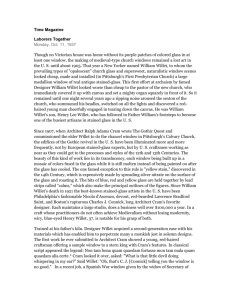Exploring Materials Stained-Glass Windows
advertisement
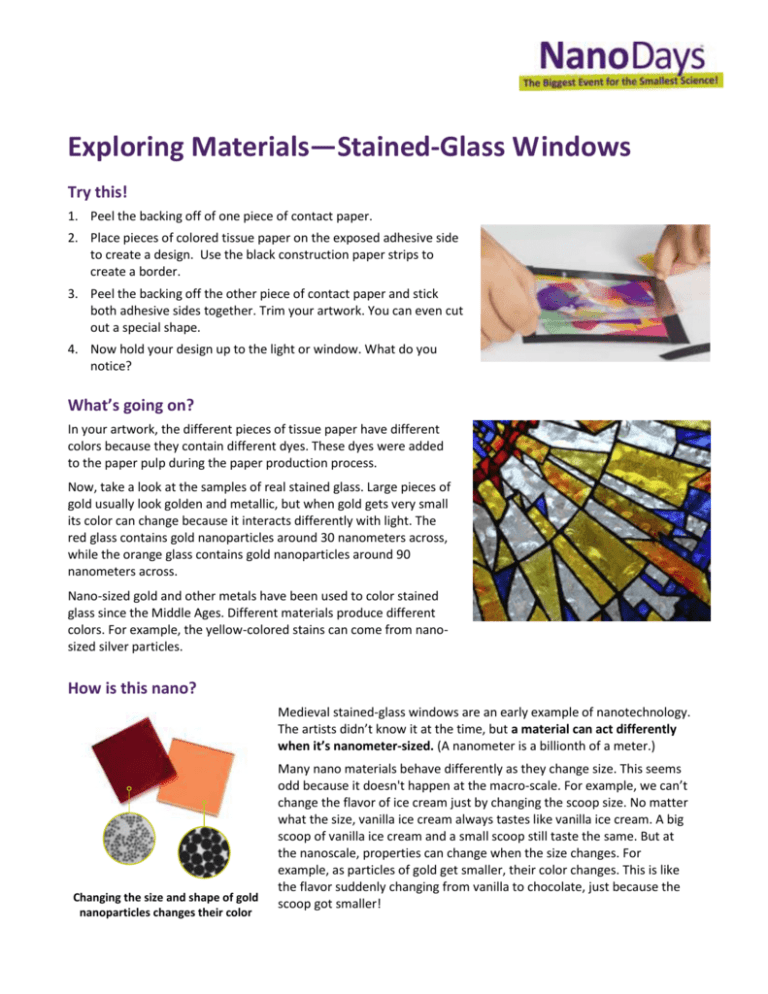
Exploring Materials—Stained-Glass Windows Try this! 1. Peel the backing off of one piece of contact paper. 2. Place pieces of colored tissue paper on the exposed adhesive side to create a design. Use the black construction paper strips to create a border. 3. Peel the backing off the other piece of contact paper and stick both adhesive sides together. Trim your artwork. You can even cut out a special shape. 4. Now hold your design up to the light or window. What do you notice? What’s going on? In your artwork, the different pieces of tissue paper have different colors because they contain different dyes. These dyes were added to the paper pulp during the paper production process. Now, take a look at the samples of real stained glass. Large pieces of gold usually look golden and metallic, but when gold gets very small its color can change because it interacts differently with light. The red glass contains gold nanoparticles around 30 nanometers across, while the orange glass contains gold nanoparticles around 90 nanometers across. Nano-sized gold and other metals have been used to color stained glass since the Middle Ages. Different materials produce different colors. For example, the yellow-colored stains can come from nanosized silver particles. How is this nano? Medieval stained-glass windows are an early example of nanotechnology. The artists didn’t know it at the time, but a material can act differently when it’s nanometer-sized. (A nanometer is a billionth of a meter.) Changing the size and shape of gold nanoparticles changes their color Many nano materials behave differently as they change size. This seems odd because it doesn't happen at the macro-scale. For example, we can’t change the flavor of ice cream just by changing the scoop size. No matter what the size, vanilla ice cream always tastes like vanilla ice cream. A big scoop of vanilla ice cream and a small scoop still taste the same. But at the nanoscale, properties can change when the size changes. For example, as particles of gold get smaller, their color changes. This is like the flavor suddenly changing from vanilla to chocolate, just because the scoop got smaller! Learning objectives A material can act differently when it’s nanometer-sized. Materials Samples of nanogold stained glass (2) Sample of gold flakes Precut pieces of clear contact paper Small pieces of multicolored tissue paper Precut strips of black construction paper Scissors “Stained-glass Art” image sheet Gold flakes are available from www.amazon.com. Stained glass samples made with gold are available from www.bullseyeglass.com (red #001311 and light orange #001823.) Notes to the presenter SAFETY NOTE: Take care using scissors with small children. Before you begin: Have small pieces of multicolored tissue paper available. Precut the contact paper to the desired size and cut strips of black construction paper for the borders. Peeling off the backing of the contact paper can be challenging. Sometimes it is hard to get the peel started. One tip is to bend and crease one of the corners. This sometimes helps to get the peeling started. During slow times, or before the activity begins, you may want to peel the corner of the backing off some pieces of contact paper to aid visitors who might have difficulty doing it themselves. Related educational resources The NISE Network website (www.nisenet.org) contains additional resources to introduce visitors to this topic: Public programs include Nanoparticle Stained Glass; Treating Tumors with Gold. NanoDays activities include Exploring Materials—Nano Gold. Exhibits include Nano Exhibition, Changing Colors, Nanomedicine Explorer, Treating Disease, and Unexpected Properties. Credits and rights This activity was adapted by the Children’s Museum of Houston from NISE Network’s Exploring Materials—Nano Gold. The original activity is available at: www.nisenet.org. Image of nano gold particles courtesy of nanoComposix. Illustration of different colored gold nano particles by Emily Maletz. Image of stained-glass, www.istockphoto.com. Images of stained-glass art, commons.wikimedia.org. This project was supported by the National Science Foundation under Award No. 0940143. Any opinions, findings, and conclusions or recommendations expressed in this program are those of the author and do not necessarily reflect the views of the Foundation. Copyright 2014, Sciencenter, Ithaca, NY. Published under a Creative Commons Attribution-NoncommercialShareAlike license: http://creativecommons.org/licenses/by-nc-sa/3.0/us/.
